What Command Can Be Used to Send Test Queries to a Target Dns Server?
What is Nslookup?
First, let's talk about what Nslookup is – information technology is a small but very powerful network administration command-line software. It has a simple interface, but it is useful. The Nslookup command is available on many of the popular reckoner operating systems like Windows, macOS, and Linux distros. You can employ it to perform DNS queries and receive: domain names or IP addresses, or any other specific DNS Records.
There are Nslookup online tools too. You lot can access such a site full of online network tools and search for the option for nslookup. Y'all can define your query for a specific DNS tape, to identify the domain, the port in utilize, and timeout in seconds. For improve security, nosotros recommend you to employ the software on your computer.
If y'all want high speed, you must employ Anycast DNS services! Check this article virtually Anycast DNS!
How to install the Nslookup command?
Nslookup command is nowadays on well-nigh operating systems like Windows, macOS, and most Linux distributions. Nonetheless, in example it is not on the Linux distro you take chosen, or you take previously uninstalled it, you tin can install it following these steps:
1. Bank check what distro do you use. We will show y'all how to install the Nslookup command on Ubuntu, Debian, Linux Mint, Kali Linux, CentOS, Fedora, Ruby Hat, Arch Linux, and Manjaro.
2. First, open the Last. You lot volition demand to accept authoritative privileges or be a sudo user. Based on the distribution you have, use one of the following commands.
For Ubuntu, Debian, Kali Linux, and Linux Mint:
$ sudo apt-become update
and and then:
$ sudo apt-get install dnsutils
For CentOS, Fedora, and Red Lid:
$ sudo dnf install demark-utils
For Arch Linux and Manjaro:
$ sudo pacman -Southward dnsutils
3. At present, y'all are ready to utilize the Nslookup command on your device and try the examples below.
Nslookup syntax
The Nslookup syntax is very simple, and you can utilise it the same on unlike OSes.
nslookup [-option] [proper name | -] [server]
Options. First, yous will put the option you desire to use with the domain name or IP accost. The pick can be related to the blazon of DNS record, timeout, a port in use, debugging, or another.
Name. Here you lot volition put the hostname (domain name) or IP address. It is the target of your DNS query.
Boosted Options. Depending on the query, yous can add together an extra option as a parameter.
Server. Yous tin use the default server for your query or specify another one from where you want the DNS query to be performed.
Nslookup: command not establish – how to set up it?
It is possible when you endeavor to use the Nslookup command that you get an error proverb that the command is not found. Don't worry. The trouble of missing the Nslookup command can be solved in a very simple way.
Nslookup is a function of the BIND utilities, together with ii other pop commands – Dig command and Host control.
If the service was stopped, you lot would demand to restart your Linux computer, and it will be running over again.
In case that it is not working because it was deleted or missing. Please follow the steps from the previous part on "How to install Nslookup command". After the installation, you volition exist fix to use it.
Here are the 10 most used Nslookup commands that will help you to understand better your domain's management:
ane. How to detect the A record of а domain.
You can use this command to see how many A records are there and see the IP Addresses of each one.
Control line:
$ nslookup example.com

Searching for e swell Managed DNS service? Test ClouDNS for free!
2. How to bank check the NS records of a domain.
By checking the NS records, you lot can see which is the authoritative server for a specific domain.
Command line:
$nslookup -type=ns case.com
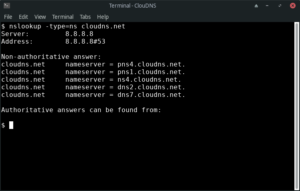
three. How to query the SOA record of a domain.
With this one, you tin see the offset of authority and get information about the zone.
Control line:
$nslookup -type=soa case.com
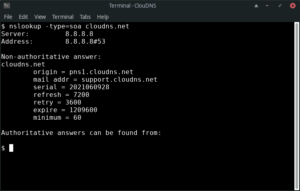
xxx-day Gratis Trial for Premium Anycast DNS hosting
four. How to find the MX records responsible for the email substitution.
Hither we are checking the MX records of the mail servers. You tin see if all the postal service servers are working well.
Control line:
$ nslookup -query=mx example.com
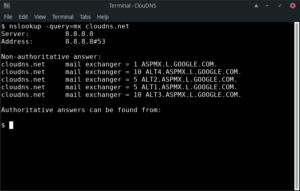
5. How to find all of the available DNS records of a domain.
This lookup has a large scope. Hither nosotros want to see all the available DNS records. After seeing all of them, nosotros tin can do specific lookups for different types of DNS records.
Control line:
$ nslookup -blazon=any example.com
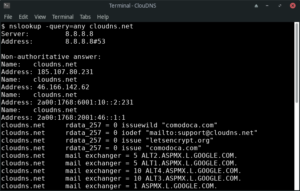
6. How to check the using of a specific DNS Server.
Apart from checking DNS records, you tin can apply the Nslookup to review a particular DNS server and how it works. You tin can bank check if it is active or if it responds on fourth dimension.
Control line:
$ nslookup example.com ns1.nsexample.com
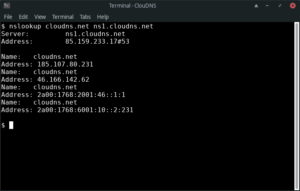
7. How to cheque the Contrary DNS Lookup.
Many times you check the A records to run into the IPs of a domain, but sometimes you lot demand to verify if an IP accost is related to a specific domain. For that purpose, we need a reverse DNS lookup.
Command line:
$ nslookup 10.20.xxx.forty
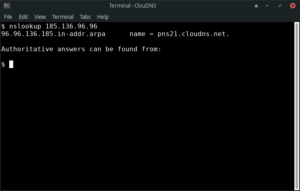
8. How to check for a PTR record?
Yous can verify if an IP address belongs to a domain name by performing a reverse DNS query. For this purpose, yous will need to check the PTR record that links an IP address to a domain name. Y'all volition need to put the IP address in reverse (185.136.96.96 changes to 96.96.136.185), and you need to add together in-addr.arpa because it is stored in arpa's top-level-domain.
Command line:
$ nslookup -type=ptr 96.96.136.185.in-addr.arpa
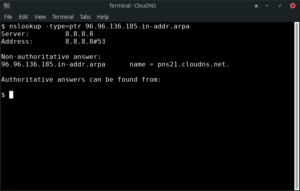
9. How to change the timeout interval for a reply.
You lot can manually choose the timeout time in seconds. You can increment it to give more time for the server to respond. You can besides shorter it to come across which servers can answer quicker.
Command line:
$ nslookup -timeout=20 example.com
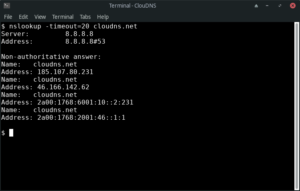
10. How to enable debug mode.
Debug mode provides important and detailed data both for the question and for the received answer.
Command line:
$ nslookup -debug example.com
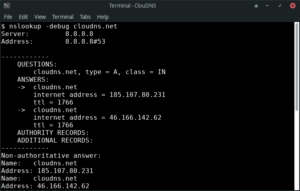
Nslookup control alternatives
Nslookup is one of the popular command-line software for DNS probing. You can use it to monitor your network and spot problematic areas. If you lot are interested in similar tools, you can come across Ping, Traceroute, Dig, and Host too.Yous can use them together or find one that covers all of your diagnostic needs.
Demand more than details what is nslookup? Check the nslookup page on wikipedia.
Notes:
Authoritative answer – This is the respond that originates from the DNS Server which has the information about the zone file.
Not-authoritative answer – When a nameserver is not in the listing for the domain you did a lookup on.
Unlike port – By default, the DNS servers use port 53.
xxx-mean solar day Gratuitous Trial for Premium Anycast DNS hosting
(Visited 398,394 times, 95 visits today)
Summary

Article Name
10 nigh used Nslookup commands
Description
What is Nslookup? Cheque the x nigh used Nslookup commands that will help you lot to empathise better your domain'southward direction.
Author
Martin Pramatarov
Publisher Name
ClouDNS.internet
Relish this article? Don't forget to share.
Tags: DNS, nslookup, nslookup cmd, nslookup command, nslookup command example, nslookup commands Last modified: January nineteen, 2022
Source: https://www.cloudns.net/blog/10-most-used-nslookup-commands/#:~:text=The%20Nslookup%20command%20is%20available,any%20other%20specific%20DNS%20Records.
0 Response to "What Command Can Be Used to Send Test Queries to a Target Dns Server?"
Post a Comment